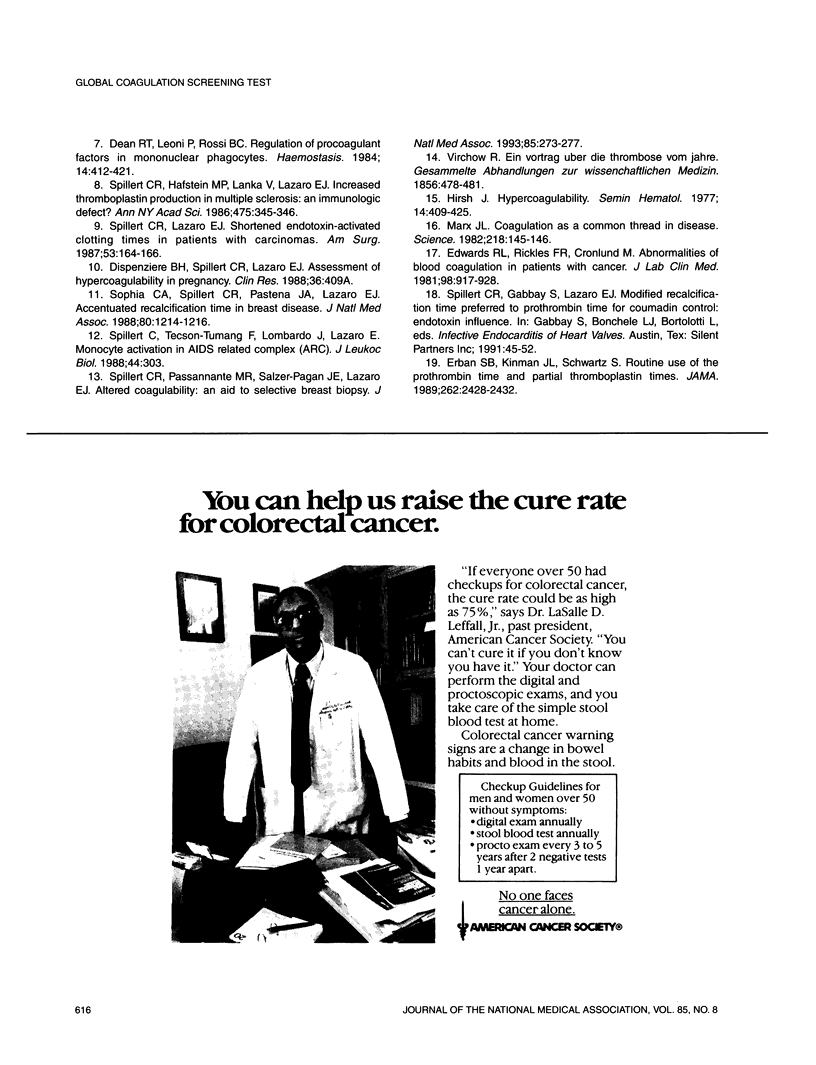Abstract
Hypercoagulability with resultant thrombosis as a leading cause of death remains unproven due to the lack of a global screening coagulation test documenting antecedent hypercoagulability. To fill this need a modified recalcification time (MRT) test that incorporates the contribution of all the circulating cellular and chemical mediators, including the important but neglected tissue factor, to coagulation is described. Aliquots of blood are incubated with saline and with endotoxin, and the MRT is instrumentally determined. Values outside the normal ranges of 5.3 to 8.5 minutes (saline) and 4.5 to 7.5 minutes (endotoxin) in the coagulation spectrum of 0 to 10 minutes to infinity are abnormal. Shorter values are inversely related to the degree of hypercoagulability. To assess MRT in detecting hypercoagulability, MRT values in conditions with known thrombotic risk that were reported individually are presented by indicating the percentages of each in the abnormal ranges. The conditions, all with statistically significant hypercoagulability, included early breast cancer, diabetes, head, neck, and colon cancer, peripheral vascular disease, and pregnancy. Modified recalcification time meets the criteria of a global coagulation screening test because of: 1) age-related prevalence of asymptomatic cancer and thrombotic cardiovascular disease, 2) specificity and sensitivity, and 3) expected lower morbidity and mortality with early intervention.
Full text
PDF





Selected References
These references are in PubMed. This may not be the complete list of references from this article.
- Dasmahapatra K. S., Cheung N. K., Spillert C., Lazaro E. An assessment of monocyte procoagulant activity in patients with solid tumors. J Surg Res. 1987 Aug;43(2):158–163. doi: 10.1016/0022-4804(87)90159-4. [DOI] [PubMed] [Google Scholar]
- Dean R. T., Leoni P., Rossi B. C. Regulation of procoagulant factors in mononuclear phagocytes. Haemostasis. 1984;14(5):412–421. doi: 10.1159/000215099. [DOI] [PubMed] [Google Scholar]
- Edwards R. L., Rickles F. R., Cronlund M. Abnormalities of blood coagulation in patients with cancer. Mononuclear cell tissue factor generation. J Lab Clin Med. 1981 Dec;98(6):917–928. [PubMed] [Google Scholar]
- Hirsh J. Hypercoagulability. Semin Hematol. 1977 Oct;14(4):409–425. [PubMed] [Google Scholar]
- Lyberg T. Clinical significance of increased thromboplastin activity on the monocyte surface--a brief review. Haemostasis. 1984;14(5):430–439. doi: 10.1159/000215101. [DOI] [PubMed] [Google Scholar]
- Marx J. L. Coagulation as a common thread in disease. Science. 1982 Oct 8;218(4568):145–146. doi: 10.1126/science.7123225. [DOI] [PubMed] [Google Scholar]
- Prydz H., Allison A. C. Tissue thromboplastin activity of isolated human monocytes. Thromb Haemost. 1978 Jun 30;39(3):582–591. [PubMed] [Google Scholar]
- Sofia C. A., Spillert C. R., Pastena J. A., Lazaro E. J. Recalcification time in breast disease. J Natl Med Assoc. 1988 Nov;80(11):1214–1216. [PMC free article] [PubMed] [Google Scholar]
- Spillert C. R., Lazaro E. J. Shortened endotoxin-activated clotting times in patients with carcinoma. Am Surg. 1987 Mar;53(3):164–166. [PubMed] [Google Scholar]
- Spillert C. R., Milazzo V. J., Pastena J. A., Lazaro E. J. Prediction of clinical course in diabetes using a simple coagulation test. J Natl Med Assoc. 1989 Jan;81(1):81–83. [PMC free article] [PubMed] [Google Scholar]
- Spillert C. R., Milazzo V. J., Suval W. D., Lazaro E. J. Hypercoagulability in arterial disease. Angiology. 1989 Oct;40(10):886–889. doi: 10.1177/000331978904001005. [DOI] [PubMed] [Google Scholar]
- Spillert C. R., Passannante M. R., Salzer-Pagan J. E., Lazaro E. J. Altered coagulability: an aid to selective breast biopsy. J Natl Med Assoc. 1993 Apr;85(4):273–277. [PMC free article] [PubMed] [Google Scholar]


